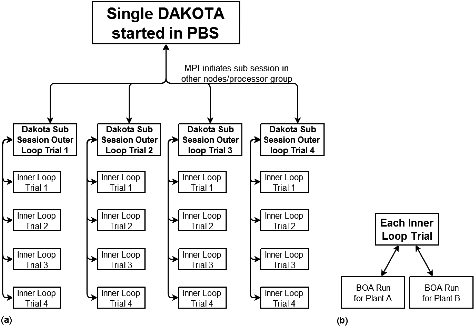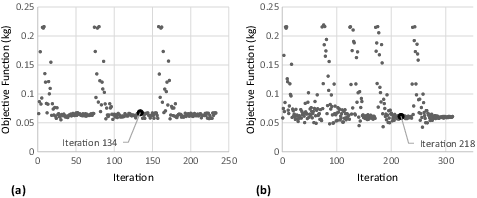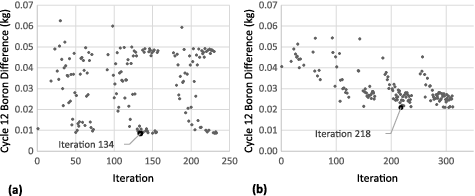 ?Mathematical formulae have been encoded as MathML and are displayed in this HTML version using MathJax in order to improve their display. Uncheck the box to turn MathJax off. This feature requires Javascript. Click on a formula to zoom.
?Mathematical formulae have been encoded as MathML and are displayed in this HTML version using MathJax in order to improve their display. Uncheck the box to turn MathJax off. This feature requires Javascript. Click on a formula to zoom.ABSTRACT
Optimization numerical method was implemented to determine several mass transfer coefficients in a crud-induced power shift risk assessment code. The approach was to utilize a multilevel strategy that targets different model parameters that first changes the major order variables, mass transfer inputs, then calibrates the minor order variables, crud source terms, according to available plant data. In this manner, the mass transfer inputs are effectively simplified as “dependent” on the crud source terms. Two optimization studies were performed using DAKOTA, a design and analysis toolkit, with the difference between the runs, being the number of model runs using BOA, allowed for adjusting the crud source terms, therefore, reducing the uncertainty with calibration. The result of the first case showed that the current best estimated values for the mass transfer coefficients, which were derived from first principle analysis, can be considered an optimized set. When the run limit of BOA was increased for the second case, an improvement in the prediction was obtained with the results deviating slightly from the best estimated values.
1. Introduction
The Boron-induced Offset Anomaly (BOA) code was jointly developed by the Electric Power Research Institute (EPRI) and the Westinghouse Electric Company (WEC) to assess the risk of crud formation in pressurized water reactors (PWRs) and the onset of crud-induced power shift (CIPS) [Citation1]. CIPS is the result of the mutualistic effect of sub-cooled nucleate boiling (SNB) on fuel surfaces, allowing crud deposition in boiling spans, and subsequent boron hideout in the thick crud [Citation2]. Boron hideout near the upper span in the fuel assemblies depresses the neutron flux distribution, shifting power generation towards the lower spans of the fuel assembly. The deposition of crud in the fuel is driven by SNB, which is the result of temperature in microscopic local region of the cladding surface being higher than the saturated coolant temperature. Assessment of CIPS risk is carried out with BOA through a detailed multi-modal calculation requiring the core design, thermal hydraulic data, and material corrosion inputs. Newer versions of BOA incorporate refined models that are more mechanistically representative of corrosion and other phenomena occurring within the PWR primary loop.
In order to correctly represent the CIPS phenomena, the entire PWR system must be modeled since the main corrosion product source is ex-core. The BOA code is a crud and boron deposition risk assessment tool designed to help utility engineers assess risk of developing CIPS. BOA uses a corrosion product mass balance approach with a number of mechanisms for deposition and release. The code includes a detailed mass evaporation model that considers specific fuel design effects as well as the effect of porous crud. Calculation of the boiling heat flux and mass evaporation rate first determines the local crud deposition on the fuel surface. Lastly, BOA predicts boron deposition in this SNB crud layer based on precipitation of lithium-borate compounds.
The release of the BOA version 3.0 code introduced a new advanced deposition model. This model provided a mechanistic approach to the precipitation, deposition, and release of nickel and iron species in the coolant and core surfaces, which is critical for calculating the core crud mass over time. This core crud mass quantity is directly affected by a group of mass transfer coefficients that define the deposition and release rates of soluble and insoluble crud particles on various wetted surfaces. These coefficients are the particle deposition constant on boiling surfaces (PDRB), the particle deposition on non-boiling surfaces (PDNB), the particle release constant in the steam generator (CKSG), the particle release constant in core on non-boiling surfaces (CKNB), and the mass transfer coefficient for calculating probability of release core on boiling surfaces (CKBL) [Citation1].
Verification and validation (V&V) testing of the updated BOA model was performed using BOA version 3.1 by testing against cycle data obtained from plants that historically have had CIPS. This model tuning process was challenging because the model prediction was directly affected by the crud source terms, which are the corrosion release of nickel and iron from the steam generator tube surfaces and from system piping and vessel internals surfaces. It is not possible to directly measure the corrosion product mass during operation, and there is known variations in plants design and system materials (including alloy, age, and exposure history), therefore, an adjustment methodology is needed to establish a plant-specific understanding of the crud source term. In the process of verifying and validating the mass transfer coefficients that are applicable to the varied designs of the current PWR fleet, it was important that the adjustment methodology developed for BOA be applied in the optimization process [Citation3].
This paper describes the use of a multilevel optimization methodology to validate and verify the mass transfer coefficients of the advanced deposition model for two plants. Optimization was performed using the Design Analysis Kit for Optimization and Terascale Applications (DAKOTA) toolkit [Citation4]. The Python scripted workflow, designed by Adams et al. for sensitivity and uncertainty analysis of CIPS with VIPRE-WFootnote1and BOA, was adopted and modified for improved hierarchical concurrency in a Linux cluster environment [Citation5]. Multilevel optimization was also chosen as the method of choice rather than other regression methods due to the changing nature of the source terms when the mass transfer coefficients get adjusted. Finally, the success of multilevel optimization here would mean the method can be used for future estimation and validation of complex variables in an automated and efficient manner.
2. Parametric studies
2.1. Mass transfer coefficients
Many equations in BOA are expressed as general mass transport reactions. The physical meaning of the mass transfer coefficients to be described here, the deposition and release reactions in BOA are defined as first-order mass transport equations for both soluble and insoluble species. Soluble species transport equations are of the form,
(1)
(1) where Js is the soluble flux to the surface, Css is the soluble species concentration on the surface, Cbs is the soluble species concentration in the bulk coolant, and kf is the film mass transfer coefficient. Note the surface concentration is determined by thermodynamic equilibrium solubility relationships. Insoluble transport equations have forms similar to Fouling equations that have a concentration-dependent deposition term and a crud mass-dependent release term, similar to the following:
(2)
(2) where Jp is the insoluble or particulate flux to the surface, S is the surface area, Cp is the concentration of particulate of the bulk coolant, mp is the particulate mass, kd is the deposition constant, and kr is the release constant. This suggests that crud accumulation is the result of deposition and release components. In BOA, the particulate deposition constants – PDRB and PDRN – are analogous to the kd, and the release constants – CKSG, CKBL, and CKNB – are analogous to the kr for different locations in the PWR primary system, steam generator, boiling, and non-boiling, respectively. A treatment of the relationship between crud and boron uptake within the BOA is described by Henshaw et al., but crud and boron are understood to have a positive relationship, where an increase in crud above a threshold will generally lead to an increase in boron uptake [Citation6].
With the release of BOA V3.1, the parametric analysis performed by Adams et al. [Citation5] for BOA was repeated to identify the new effective range of the mass transfer coefficients for later optimization. Modification to the original work was made by expanding the ranges of the inputs to several orders of magnitude in both directions from nominal. This was to observe the limit of the BOA code predictions and to select feasible limits for later optimization. Footnote2shows the results of this new sensitivity analysis obtained by using the Centered Parameter Study in DAKOTA for the four mass transfer coefficients.
Figure 1. Centered parameter studies of the effect of (a) particle deposition, (b) out-of-core particle release, (c) in-core non-boiling particle release, and (d) mass transfer coefficient for escape probability of boiling on the cycle core boron mass for Unit A with prior source terms adjustments.
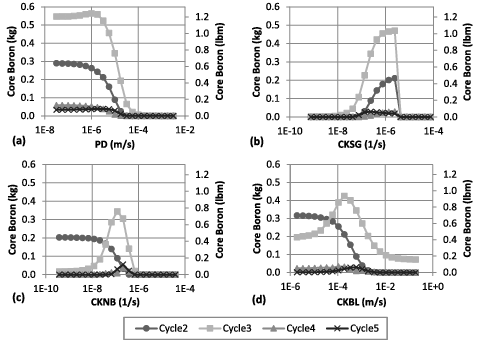
Note the core boron mass is assumed to be directly correlated to the crud mass on the fuel [Citation3]. The core boron mass is the total mass of boron that is deposited on the entire fuel assembly surface. In BOA, the multiple particle deposition constants are equated to a single term, PD, which meant crud particle deposition was the same regardless of whether there is boiling or no boiling, or if there were different temperatures or surface conditions. This assumption was made due to the fact that boiling mass transfer generally dominates the overall mass transport given flow conditions are relatively similar, and other factors, such as electrostatic driving forces, have not been found to be significant.
a) shows that PD has a negative correlation with the core boron mass, where significant change was observed from 1 × 10−6 to 1 × 10−4 m/s. This relationship can be explained as a consequence of this indiscrimination, which meant crud deposition is influenced by surface area of the boiling surfaces and the non-boiling surfaces. Because the steam generator and wall tubes have a significantly higher surface area than the fuel assemblies, particle deposition is generally favored on out-of-core surfaces. When the PD term is elevated, the impact of non-boiling surface area becomes more pronounced, resulting in more crud depositing on the non-boiling surfaces. This leads to less crud deposits on the fuel and less hideout locations for boron.
In contrast to particle deposition, particle releases are governed independently for different surfaces, which are differentiated by the presence of SNB and whether the surface is in-core or out-of-core. The release for all out-of-core surfaces, which is generally dominated by the steam generator, is controlled by CKSG. b) shows that as CKSG value increases, the core boron increases. The increase in core boron is attributed to the crud release from the steam generator that then deposits in the core and causes increased boron hideout on the fuel. At values greater than 2.4 × 10−6 s−1, BOA prediction becomes nonsensical, and the code returns undefined results reported as not-a-number (NaN) values – which is represented as a 0 in b). Effective range for CKSG would thus, be from 1 × 10−8 to approximately 1 × 10−6 s−1 to avoid NaN outputs. The difference in unit for CKSG is related to modeling simplifications and because steam generator release is not influenced by the total surface area but is a function of the molar mass of deposited crud on the surface.
Releases from surfaces without SNB occurrence are controlled by the CKNB constant. Unlike PD and CKSG, particle release in-core for non-boiling surfaces (CKNB) is much more complicated to summarize because of the surface area dependency on SNB occurrence (or lack of), which is affected by many factors that are constantly changing during a cycle operation. However, bases for this release constant have been investigated by EPRI in 1985 [Citation7], and earlier reports have estimated this to be 2.6 × 10−7 s−1 using available plant data from 1970s and 1980s [Citation8,Citation9]. c) shows the effect of CKNB on the core boron mass with the sensitive range from 1 × 10−8 to 1 × 10−6 s−1. At very high CKNB values, it is expected that crud release should theoretically reach a limit where no more crud could be release into the system. When this occurs, BOA predictions become erratic, similar to the case of high value of CKSG. This explains why the boron mass start rapidly declining towards zero beyond 1.0 × 10−7 s−1. Similar to CKSG, CKNB is also given a unit of s−1 because particulate release is not influenced by the total surface area but is a function of the molar mass of crud on non-boiling surfaces in the core.
Particle release for in-core surfaces undergoing SNB is dynamically controlled using the escape probability model. The probability of escape, or CKBL, is defined as
(3)
(3) where km is the mass transfer coefficient for particles released from a boiling surface and U is the boiling velocity. Notice that with increasing boiling rate, the boiling velocity will increase, and the escape probability will decrease. This suggests that higher steaming rates will have less release from the boiling surface. Release for SNB surfaces on the fuel is estimated as a fraction of the release constant for non-boiling surfaces, CKNB. This dependency on CKNB is reflected in the bell shape shown in d). The range for CKBL for BOA was observed to be 1.0 × 10−4 to 1.0 × 10−2 m/s, where the Cycle 2 boron mass is shown to be more responsive. Boiling release is a function of the boiling velocity and the molar mass of deposited crud, therefore, the units of CKBL are m/s.
2.2. Source terms
Corrosion product release rates among operating PWRs have been shown to have considerable variability by the examination of shutdown chemistry data. BOA tuning methodology applies adjustments of a “multiplier” that scales the nickel corrosion rate (CREL), the iron corrosion rate (CRELFE), and the crud retention factor (FM) concurrently. This “multiplier” is plant specific allowing the models to capture the variability in plant behavior. shows the effects of the multiplier on the cycle core boron mass. The correlation between multiplier and boron is observed to be positive, which is logical as the increase in the multiplier value enhances corrosion and the amount of crud in the coolant for plant wide crud deposition and boron hideout.
Figure 2. Effect of the multiplier on the core boron mass for Unit A. A multiplier value 0.79 effectively “tunes” the unit.
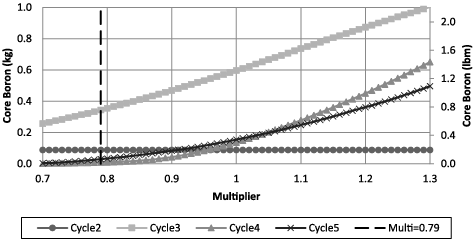
Tuning a plant-specific multiplier is performed by matching the predicted boron mass of the second and third cycles in a sequence with the boron mass calculated from the axial offset (AO) or to a lower limit if no AO was observed. While the adjustment is simple, any changes in the mass transfer coefficients can result in inaccurate boron predictions unless the multiplier is also adjusted.
3. Methodology for optimization
3.1. BOA CIPS criteria
The objective of the BOA code is to accurately assess the risk of CIPS occurrence. Of the three driving factors – SNB, core boron mass, and crud thickness – the BOA User Manual emphasizes the core boron mass as the key factor in assessing CIPS risk, where higher core boron mass indicates a higher risk of CIPS occurrence. In this work, the risk of CIPS in two PWR units was assessed: “A” with one previous cycle containing a CIPS observations and “B” with three previous cycles containing CIPS observations. These two units were selected for their many similarities, shown in , which can drive the search towards an optimized group of mass transfer coefficients.
Table 1. Nuclear steam supply system (NSSS) characteristics of Unit A and Unit B.
The current BOA methodology requires at least three sequential cycles of data to adjust the source terms prior to using the tool for prediction. The first two cycles establish the initial crud inventory and allow for adjustments to the corrosion release and corrosion rates constants (BOA model parameters CREL, CRELFE, and FM) in order to match observations (primarily the observations of CIPS). The third cycle is used for verifying or benchmarking the source-term adjustments made for the previous cycles. The boron data for Unit A and Unit B, as shown in , are determined by so called “gray rod” analysis [Citation10]. Unit B, with four cycles, is a special case where the initialization cycle, Cycle 9, had experienced significant CIPS in the core. An additional “known” cycle is added, providing three cycles, where adjustments can be made before benchmark in the fourth cycle.
Table 2. Plant CIPS history for Unit A and Unit B.
3.2. Defining the optimization problem
The objective function was defined as average of the difference between predicted and target core boron as shown,
(4)
(4)
For a CIPS cycle, the target boron is listed in . For a non-CIPS cycle, the target boron is zero rather than the CIPS threshold. Initial cycles, Unit A Cycle 2 and Unit B Cycle 9, are not included because their values are not affected by the source terms multipliers [Citation1]. In addition, the optimization problem was subjected to constraints listed in , which are derived in part from the CIPS data in . The constraints set upper and lower boundaries conditions that must be meet before DAKOTA will consider a parameter value feasible.
Table 3. Output constraints used for defining convergence criteria.
In addition to output constraints, the input constraints were also specified. shows the upper and lower boundary constraints determined from the results of parameter study in Section 2. Note these values differ from because the optimization boundaries are different from the sensitivity studies. DAKOTA optimizer will vary these variables within the bounds, with the initial values serving as a starting point for the search.
Table 4. Input constraints used for limiting ranges of possible solution.
3.3. DAKOTA interface and parallelization configuration
Optimization of BOA was carried out using the DAKOTA version 5.3 toolkit developed by Sandia National Laboratories [Citation4]. DAKOTA allows for iterative system analysis and contains a library of algorithms for optimization, sensitivity analysis, uncertainty quantification, and parametric study. Modified Python scripts, developed by Adams et al., were used for interfacing BOA with DAKOTA as black box analysis that only analyzes the input and output [Citation5].
shows the multilevel optimization that was implemented for BOA as inner and outer loops due to the inter-relationship between the crud source terms (controlled by the multiplier) and the mass transfer coefficients. The outer-loop optimization is designed to target and adjust the four mass transfer coefficients. With each adjustment, the inner loop optimizes the source terms by varying the multipliers, analogous to the source terms adjustment described in the BOA User Manual.
Figure 3. Implementation of multilevel optimization. Arrows on the left are input while arrows on the right are collected outputs fed back to the optimizer.
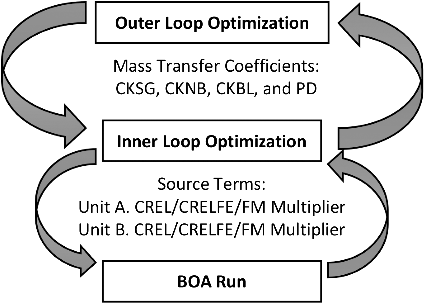
Availability of computational resources is a key factor limiting the use of multilevel optimizations. This implementation in BOA was no exception, although the problem was greatly simplified by reducing the number of variables. However, BOA optimization was limited to no more than 1000 iterations in the outer loop, and up to 32 iterations in the inner loop. This meant approximately 32,000 individual BOA runs for each reactor unit as a result of the iterative nature of the process. On a typical desktop computer, this type of study would take a calendar month.
Applying this optimization strategy was possible with the availability of Phoebe, EPRI's high-performance computer (HPC), which greatly reduced the runtime from weeks to days [Citation11]. Concurrency support was implemented using OpenMPI and PBS script submission, which allowed for segmentation of one outer-loop iteration to specific processors node on Phoebe. The total concurrency at each level was dependent on the number of variables, which is analogous to the degrees of freedom. Using the non-gradient algorithm Asynchronous Parallel Pattern Search for the Outer loop and the Coliny Pattern Search for the Inner loop [Citation4], the maximum concurrency at each level was twice the number of variables. With 4 variables in the outer loop and 2 variables in the inner loop, a total of 32 concurrent evaluation runs was possible at any time. Further improvements to the parallelization were obtained by splitting the thread to handle separate plant BOA analysis, Unit A and Unit B, in parallel rather than in sequence. This effectively doubled concurrency from 32 to 64. illustrates the process setup for concurrency.
4. Results
Two optimization runs were completed, with the difference being the inner-loop iteration limit. Run 1 was limited to 24 iterations while Run 2 had a limit of 32 iterations. Optimization was completed after 233 outer iterations for Run 1 and 312 outer iterations for Run 2. The mass transfer coefficients obtained through both runs are reported in . The optimized set of parameters was reported to have occurred at Iteration 134 for Run 1 and Iteration 218 for Run 2. shows the objective function improvement over each iteration, with each point representing the objective function calculated using a unique set of mass transfer coefficients. In both runs, the objective function at Iteration 134 and Iteration 218 were not the lowest possible value. This suggested that the convergence criteria were not based solely on the objective function but other factors, such as the output constraints.
Table 5. Mass transfer coefficients after DAKOTA optimization runs.
Insight into the DAKOTA algorithms decision-making process for convergence was gained by counting the occurrence when specific constraint were met, as shown in and . From , it was observed that the Unit B Cycle 12 core boron mass constraint was rarely satisfied for both Runs, only met 6% and 14% of the time. From the cumulative constraint count, , no occurrence of a trial meeting all 14 constraints was tested, which meant that Unit B Cycle 12 core boron mass was the limiting factor to convergence. Given this, the DAKOTA criteria for convergence would be a minimal Cycle 12 core boron mass difference from the upper boundary. confirms this as Iteration 134 and Iteration 218 had the smallest Cycle 12 core boron mass difference from threshold.
Table 6. Percentage of constraints met for Unit A.
Table 7. Percentage of constraints met for Unit B.
Table 8. Combined constraint frequency
5. Discussion
The BOA best estimated values for the mass transfer coefficients are derived through a first principle basis and adjustment manually to plant observations. While details of the original derivation are considered proprietary, general description of the process is described below. The particulate deposition constant, PD, was derived by comparing the coolant particulate decay rate for different PD values following the release of crud from the core. The decay rate that matches closely with what was observed was selected as the best value. Using this estimated value of PD as a starting point, other release constants were estimated using data from crud scraping, such as crud thickness and boiling velocity from past studies.
Considering the results of the systematic determination of these constants and given the wide range of inputs for the mass transfer coefficients, it was interesting that Run 1 converged back to the initial, manually derived best estimates. Despite the slight increase in the mass transfer coefficient for calculating the escape probability, comparison of the core boron mass obtained with optimized parameters in shows no difference from those with the best estimates. This ultimately validated the first principles basis used for estimating the mass transfer coefficients and the previous approach in verifying the coefficients in BOA version 3.1 [Citation1,Citation3].
Table 9. Core boron mass comparison.
Run 2, on the other hand, shows slight deviation from the initial best estimates for three of four coefficients. While the values were varied, they were within the same order of magnitude as the best estimate and hence, were considered not significant in altering the final assessment of CIPS. From the parametric studies, , these changes are the equivalent of approximately one tick mark on the logarithmic scales, which is considered not significant enough to drive the cycle core boron mass away from their targeted values. Out-of-core particle release, CKSG, was the only parameter left unchanged. Particle deposition, PD, and non-boiling particle release, CKNB, were slightly increased from the best estimates, which was also the initial starting point. Mass transfer coefficient for escape probability calculation, CKBL, was reduced by half, which meant an effective smaller probability of escape and a smaller particle release on SNB surfaces. Though not immediately apparent, these changes together improved the separation between CIPS and non-CIPS cycles for the tested plants and cycles, as shown in
It is interesting to mention that the only difference between Run 1 and Run 2 is eight additional inner-loop (multiplier optimization) iteration steps. Although not shown here, iteration limits affected the time and accuracy of inner-loop completion, and can affect the overall search pattern in the outer loop. A smaller inner-loop iteration limit can reduce the completion time at the expense of some uncertainty associated with the source-term adjustment. A larger limit can reduce the uncertainty though the computation time required for completion can be significantly increased. A balance of inner-loop iteration limit is necessary. This raises the question of how certain the result from Run 1 or Run 2 should be trusted compared in the case if they were significantly different than the best estimated values. It should be noted that the best estimated values were tested against more than 140 cycles of plant operation during the beta testing of BOA version 3.1 and BOA only failed to predict 2 cases of mild CIPS out of the total 140 cycles modeled [Citation1,Citation3]. Run 1 and Run 2 were only carried out for two plants with limited cycles and runtime. Certainty of optimization, if it were to replace manual testing, will require more plants and cycles.
6. Conclusion
A multilevel optimization method was developed and implemented for BOA V3.1 with the purpose of validating and improving the estimation of dependent variables. Two different optimization runs were performed, with each run differing in the iteration limit of the inner loop.
The convergence of Run 1 back to the starting best estimates suggests they were already a point on the optimized solution space. This outcome validates the best estimated values currently in BOA V3.1 and further supports the first principle approach that was used to derive the values. In addition to validation, improvement was observed in the case of Run 2, which showed a larger separation between CIPS and non-CIPS cycles. This improvement was obtained through minor adjustments of three of the four mass transfer coefficients.
Overall, the implemented method described here is a promising tool for future BOA code development. The use of inherent concurrency of some optimization algorithms allows utilization of available resources from HPCs to perform advanced testing and analysis that was not previously possible. This technique can reduce time spent in V&V of new models through a massive parallelized study of the models against many different plants.
Acknowledgements
This work was funded through a contract with the Electric Power Research Institute, Fuel Reliability Program (P41.02.01).
Disclosure statement
No potential conflict of interest was reported by the authors.
Notes
1. VIPRE (Versatile Internals and Component Program for Reactor EPRI) is a thermal-hydraulic code originally developed for EPRI, and later adopted by Westinghouse as VIPRE-W [Citation12].
2. The initialization run, Cycle 2, is shown but its significance is minimal for CIPS assessment. The purpose of the first cycle is to set up the system crud inventory for depositions and release in sequential cycles.
References
- Boron-induced Offset Anomaly (BOA). Risk assessment tool, version 3.1. Palo Alto (CA): EPRI; 2013. (no. 3002000831).
- PWR Axial Offset Anomaly (AOA). Guidelines, revision 1. Palo Alto (CA): EPRI; 2004. (no. 1008102).
- Boron-Induced Offset Anomaly (BOA). Risk assessment tool version 3.1: validation and verification. Palo Alto (CA): EPRI; 2014. (no. 3002002889).
- Adams BM, Bohnhoff WJ, Dalbey KR, et al. DAKOTA, a multilevel parallel object-oriented framework for design optimization, parameter estimation, uncertainty quantification, and sensitivity analysis: version 5.3 user's manual. Albuquerque (NM): Sandia Technical Report; 2013. (no. SAND2010-2183).
- Adams BM, Sung Y, Secker JR. CASL L1 milestone report: CASL.P4.01, sensitivity and uncertainty analysis for CIPS with VIPRE-W and BOA. Albuquerque (NM): Sandia Technical Report; 2011. (no. SAND2011-9445).
- Henshaw J, McGurk JC, Sims HE, et al. A model of chemistry and thermal hydraulics in PWR fuel crud deposits. J Nucl Mater. 2006;353:1–11.[CrossRef]
- The CORA-II model of PWR corrosion-product transport. Palo Alto (CA): EPRI; 1985. (no. NP-4256).
- Walton GN, Hesford E. The migration of activated corrosion products in high-pressure water loops. Proceedings of the Conference Corrosion of Reactor Materials; 1962 Jun 4–9; Salzburg. Vienna: IAEA; 1962. p. 547–556.
- Walton GN. A method for estimating activity transport in pressurized water reactors from measurement in loops. Trans Am Nucl Soc. 1964;7:180–182.
- Root cause investigation of axial offset anomalies. Palo Alto (CA): EPRI; 1997. (no. TR-108320).
- Wells DM. BOA parameter optimization using DAKOTA. In: Workshop on High Performance Computing and Modeling & Simulation; 2014 Oct 14; Charlotte (NC).
- VIPRE-01 MOD02.3 benchmarking to OECD/NRC BFBT void fraction test data. Palo Alto (CA): EPRI; 2009. (no. 1019095).

